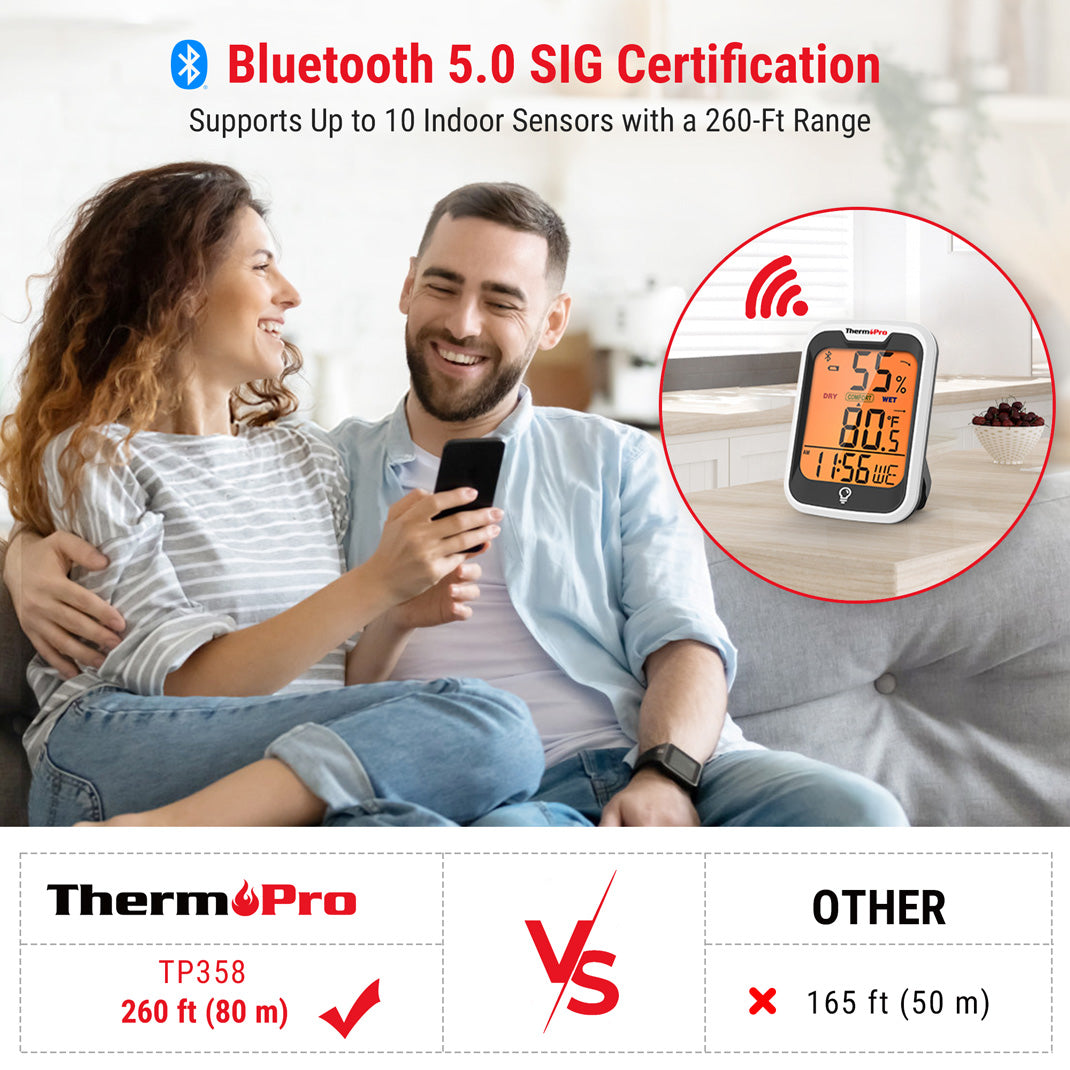Ideal Temperature and Humidity for a Greenhouse






 288 Comments
288 Comments
Creating the perfect indoor growing environment involves more than just placing plants under a roof and hoping for the best. The ideal temperature and humidity for a greenhouse plays a crucial role in helping your plants flourish throughout the seasons.
By understanding how to regulate these factors, you can look forward to healthier foliage, richer blooms, and more abundant harvests. This guide will discuss the best ways to maintain stable conditions, highlight strategies for achieving the ideal greenhouse temp and humidity, and introduce a top-tier monitoring tool—the ThermoPro TP359 Bluetooth 260-ft Indoor Hygrometer/Thermometer—that makes greenhouse management easier and more efficient.
Why Temperature and Humidity Matter in a Greenhouse
Greenhouses are designed to recreate a plant’s preferred climate on your own terms. Temperature and humidity levels have a direct influence on plant growth, disease prevention, and overall productivity. When you zero in on the ideal greenhouse humidity and temperature conditions, you’re essentially offering your plants a comfortable environment that encourages robust root development, stronger stems, and vibrant leaves.
- Temperature: Maintaining a consistent, moderate range is vital. Most common greenhouse plants thrive when daytime temperatures hover around 70–80°F (21–27°C) and dip to about 60–65°F (15–18°C) at night. These slight fluctuations help plants absorb nutrients, grow steadily, and rest properly in the evening hours.
- Humidity: The ideal greenhouse humidity level often ranges from 50% to 70% relative humidity, depending on the plant varieties you’re growing. Too little moisture in the air can cause wilting and stress, while too much invites fungal diseases. Striking the right humidity balance ensures that your plants remain hydrated without becoming susceptible to mold or mildew.

Achieving the Ideal Temperature and Humidity for a Greenhouse
Ventilation and Airflow
Fresh air movement is fundamental to keep your greenhouse at the ideal temp and humidity for greenhouse success. Proper ventilation helps circulate air, prevents stagnation, and reduces the risk of fungal outbreaks. Install roof vents, side vents, or louvered panels to regulate airflow. On warm days, open them wide to release excess heat; on cooler days, keep them partially closed to lock in warmth.
Heating and Cooling Mechanisms
Heaters, heat mats, and thermal mass (such as water barrels that store heat) can sustain adequate temperatures during cold snaps. Meanwhile, fans and shading materials help you cool the space down on especially hot days. Consider automated systems—thermostat-controlled heaters and vents—that respond to changes and maintain your ideal temperature and humidity for a greenhouse with minimal manual intervention.
Strategic Plant Grouping
Not all plants crave the same climate. Grouping species with similar environmental needs makes it easier to maintain conditions that suit them. For instance, delicate orchids might need slightly higher humidity, while succulents prefer a drier atmosphere. By placing plants with similar requirements together, you can fine-tune your greenhouse climate for better overall harmony.
Proper Watering Routines
Your watering habits directly affect humidity levels. Overwatering raises moisture in the air, potentially pushing past the best humidity for greenhouse growth. Try to keep water at the root level rather than sprinkling foliage. This method keeps leaves drier and reduces the chance of fungal issues. Drip irrigation systems or soaker hoses provide consistent moisture without contributing too much humidity to the air.
Insulation for Seasonal Shifts
In regions with distinct seasonal changes, you’ll need to think ahead. Adding insulation or installing double-glazed panels can help stabilize temperatures during colder months. Reflective blankets, bubble wrap, or thermal screens allow you to retain warmth at night, preventing drastic temperature drops that stress plants.

Monitoring Conditions with a Greenhouse Temperature and Humidity Monitor
Even if you’ve taken all the right steps, there’s no substitute for accurate data. A greenhouse temperature and humidity monitor provides real-time feedback so you can make informed decisions. A reliable tool gives you clarity: Are you actually hitting the ideal greenhouse temp and humidity targets, or do you need to adjust your equipment?
When choosing a temperature and humidity monitor, look for:
- Precision: You need accurate measurements to know when adjustments are necessary.
- User-Friendliness: Straightforward displays, easy installation, and intuitive controls matter.
- Connectivity Options: The ability to pair with smartphones or tablets can make climate management more convenient, allowing you to check on conditions without stepping outside.
- Long-Term Data Storage: Historical data can guide your decisions over time. Tracking trends reveals what’s working and what needs improvement.
Introducing the ThermoPro TP359 Bluetooth Hygrometer Thermometer
To maintain the ideal temp and humidity for greenhouse cultivation, consider adding the ThermoPro TP359 Bluetooth 260-ft Indoor Hygrometer/Thermometer to your toolkit. This device stands out as a reliable greenhouse thermometer and humidity monitor thanks to several key features:
- Swiss-Made Sensirion Sensor: Its top-tier sensor technology delivers exceptional accuracy—up to ±0.5°F and ±2%RH. That level of precision is essential when fine-tuning conditions for sensitive plants.
- Bluetooth Connectivity with 260-Foot Range: The ThermoPro TP359 connects to a user-friendly mobile app, allowing you to check readings from throughout your home. With its long-range Bluetooth signal, you can stay informed without making countless trips to the greenhouse.
- Instant App Alerts: If conditions stray outside your pre-set ranges, you’ll receive immediate alerts on your smartphone. This means you can react quickly, whether that involves adjusting vents or tweaking your watering schedule.
- Historical Data Storage and Graphs: Understanding how temperature and humidity fluctuate over days, weeks, and months can help you refine your approach. The TP359’s app stores up to a year’s worth of data, giving you insight into seasonal changes and helping you maintain the ideal greenhouse humidity over the long haul.
- Easy-to-Read Backlit LCD: The humidity and temperature monitoring’s large backlit display ensures you can read measurements at a glance, no matter the time of day.

Why the ThermoPro TP359 Is Ideal for Busy Growers
If you’re juggling multiple responsibilities—family, work, and daily errands—the TP359 offers convenience and peace of mind. Its alerts mean you won’t be caught off-guard by sudden climate shifts. For busy parents, this practical feature ensures your greenhouse conditions stay optimal without frequent manual checks. It’s a smart investment that saves time and reduces guesswork, allowing you to maintain a thriving environment even on your busiest days.

Practical Tips for Long-Term Success
- Seasonal Adjustments: As weather changes, be prepared to tweak your greenhouse settings. Add shading material when the summer sun becomes intense, or insulate more carefully during winter’s chill.
- Regular Cleaning and Maintenance: Dusty vents, clogged fans, or old insulation can throw off your carefully balanced climate. Simple maintenance—like wiping down surfaces, cleaning filters, and checking seals—goes a long way toward preserving the ideal greenhouse temp and humidity.
- Experiment and Learn: Every greenhouse is unique, from layout and location to the types of plants you grow. Don’t hesitate to experiment. Over time, you’ll develop a feel for what your greenhouse needs to remain stable and productive.
Conclusion
Maintaining the ideal temperature and humidity for a greenhouse is both an art and a science. By understanding your plants’ needs, fine-tuning watering practices, ensuring proper airflow, and relying on a precise humidity sensor for greenhouse conditions, you set the stage for lush, thriving vegetation. Incorporating a high-quality humidity meter for greenhouse management—like the ThermoPro TP359—lets you track real-time conditions, receive timely alerts, and confidently adjust settings to keep your plants happy and healthy. With these strategies and tools in place, your greenhouse can become a year-round haven, delivering a steady supply of vibrant, flourishing crops.



















